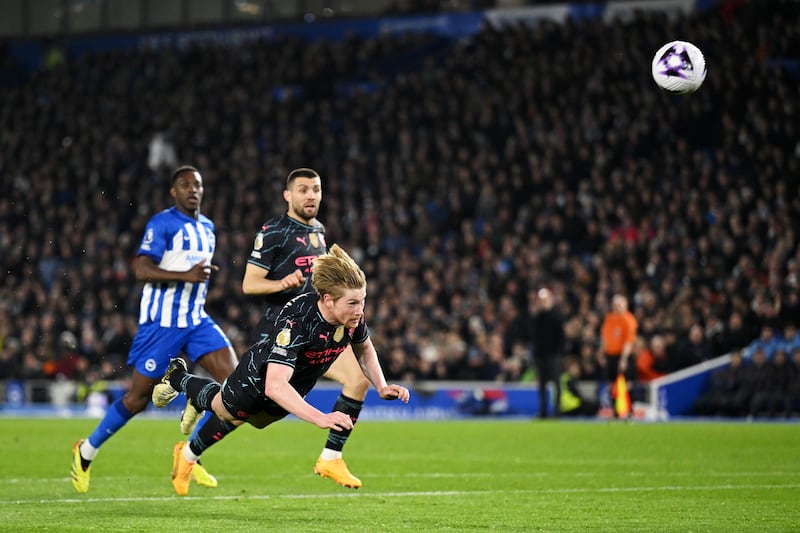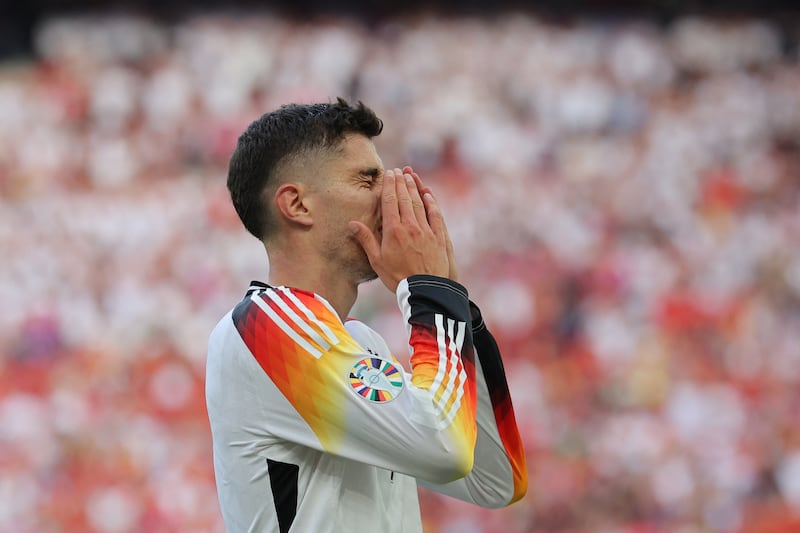Remember diving headers? When Kevin De Bruyne scored a beauty for Manchester City against Brighton a couple of months ago it was greeted like an apparition. For generations they had been a staple of kickabouts, as long you had grass for take-off and landing. Overhead kicks and diving headers were like doing wheelies on your bike or cycling with no hands.
Diving headers, though, became the victims of environmental change. It was unintentional and unannounced and irreversible. The way of life in the penalty box had changed. There were fewer, and more circumspect, crosses. And on the end of crosses there were fewer centre forwards.
Two used to be the norm until one became the fashion. Then they dreamed up teams with none. “False nines” were the new accessory for coaches who wanted to show their friends that they could do wheelies and cycle with no hands on the bike.
Outside of scoring goals, the terms of employment for centre forwards were redrafted too. They would trigger the high press, they would drop off and link the play, they would create opportunities for their funky wingers – the new rock stars of the scoring zone.
Lineout struggles cause concern for Ireland against Japan
Malachy Clerkin: Gianni Infantino inventing the Fifa Peace Prize for Trump is humiliating all round
Even in their darkest moments, Cork City can surprise both their supporters and themselves
‘The sessions are like a maths exam’: Managing the club-intercounty training balance
There were bound to be consequences. The major football tournaments provide a snapshot of the game and its prevailing tendencies and these European Championships have been a wasteland for centre forwards.
In the 12 knockout games so far, Harry Kane and Breel Embolo are the only centre forwards to have scored and the race for the Golden Boot is being led by a cluster of players who line up elsewhere. Not far away, but not down the middle.
One of those is Cody Gakpo. Liverpool persevered with him as a central striker last season, with mixed results. For the Netherlands in this tournament he has flourished coming in off the left.

Georges Mikantadze is the only centre forward in the hunt for the Golden Boot – joint top of the standings with three goals. And even though Georgia have been eliminated, he still has a fighting chance. The remarkable thing about Georgia, though, was they played two centre forwards – one of only two teams in the tournament to do so. Slovenia were the other. Two teams out of 24.
Remember when everyone did it? Over time, though it is hard to say when exactly, the practice of playing two up front – often a big ‘un and a little ‘un – became antiquated: John Toshack and Kevin Keegan; Paul Mariner and Alan Brazil; Graeme Sharpe and Tony Cottee; Niall Quinn and Charlie Nicholas; Niall Quinn and David White; Niall Quinn and Kevin Phillips.
Two strikers had been a function of 4-4-2, but in the tapas bar of modern coaching, 4-4-2 was bacon and cabbage.
At these European Championships the exciting attacking play has come from wide players: Lamine Yamal, Nico Williams, Jamal Musiala, Rafael Leao, Gakpo. Ordinarily, Kylian Mbappé would be the first name on that list, but not this time, or not yet. Giddy projections for the impact of Phil Foden or Bukayo Saka have been unrealised so far.
The billboard centre forwards? Kane has looked tired and wooden. Robert Lewandowski carried an injury into the tournament and failed to make an impression; in any case he will be 36 next month.

Cristiano Ronaldo, one of the greatest goal scorers in the history of the game, is only playing through the middle now because he no longer has the wheels to play out wide. In the grand traditions of the playground, he has turned into a goal-hanger. He will be 40 in February.
Romelu Lukaku suffered a couple of VAR chalk-offs but butchered other chances and failed to score in four matches. Rasmus Hojlund did nothing. Aleksandar Mitrovic, an old-school number nine in many ways, dropped in from his retirement home in Saudi Arabia and played like a blunt instrument.
Serbia had the option of playing Dusan Vlahovic as their central striker, but instead he sat in behind Mitrovic. Vlahovic had a terrific season with Juventus and was named the best striker in Serie A. In the Euros, that form deserted him.
Alvaro Morata, Spain’s captain, has scored only once and has essentially been eclipsed by his wide players, but at the last Euros he led the tournament’s statistics for the most “big chances” missed (six); so far, he has avoided that indignity.
Germany have had to settle for Kai Havertz as their centre forward, just as Arsenal did. His form, and his finishing, improved in the second half of the season, but Mikel Arteta was still bombarded with commentary about Arsenal’s urgent need for a number nine. They were linked with Ivan Toney in the January transfer window and Alexander Isak in recent weeks and it seems certain that they will plunder the market for someone.

But it is the nature of the modern game that Arsenal could still take their title challenge to the last day of the season without a recognised, established, prolific centre forward. Manchester City obviously had Erling Haaland, but Pep Guardiola is one of the modern coaches who developed the role of a false nine, or a 9½, and in the season before Haaland arrived they won the Premier League without a full-time central striker.
Of the top 10 goal scorers in the Premier League last season, only four of them were centre forwards. Manchester United beat City in the FA Cup final without a centre forward in their starting 11.
The game never stops changing. Between 2011 and 2021 the number of crosses in the Premier League dropped by 25 per cent. Stats Perform established that the average cross from open play creates a goal just 1.3 per cent of the time. If you widen the lens to the six seconds of play after a cross lands, the figure is 2 per cent. There had to be more efficient ways of creating chances.
The dynamics changed, fundamentally. The centre forward was still pivotal but in a different way. That’s not right or wrong, just not what it used to be.
Still, I miss diving headers.

















